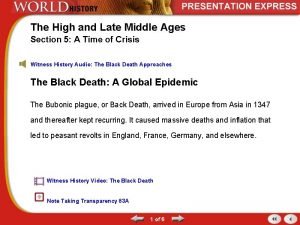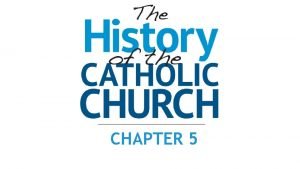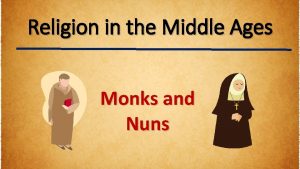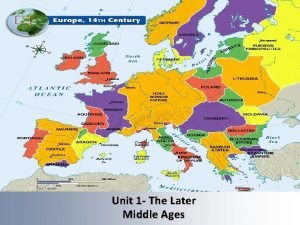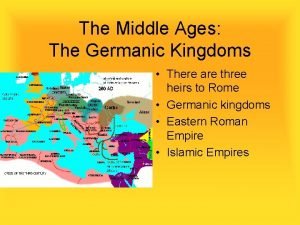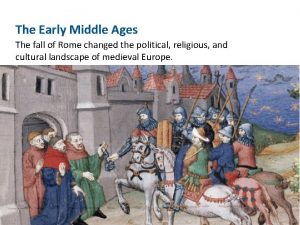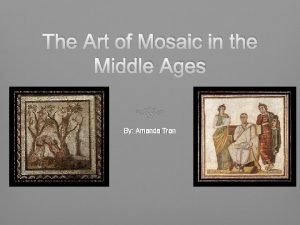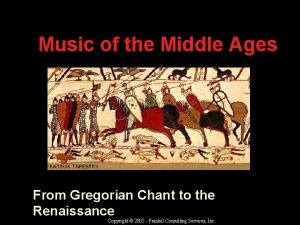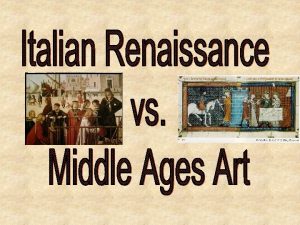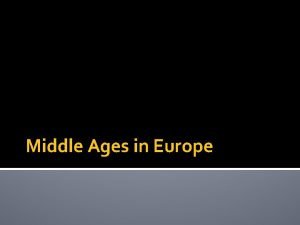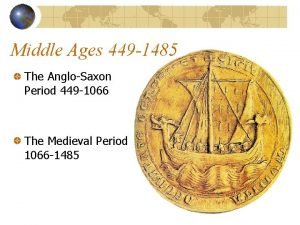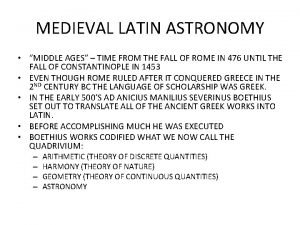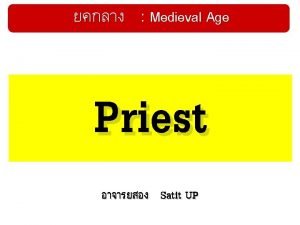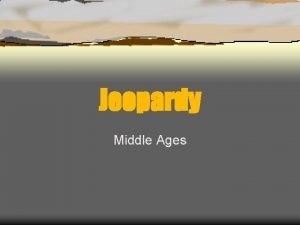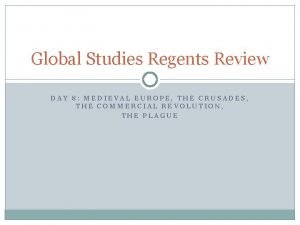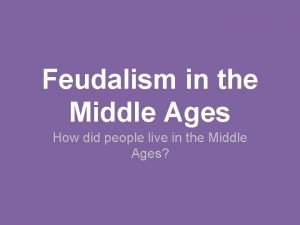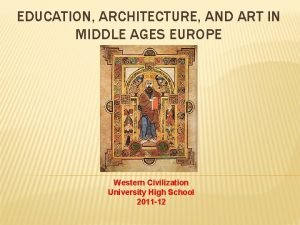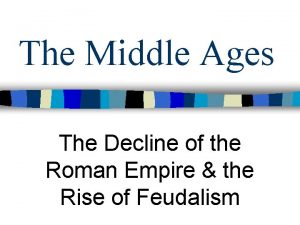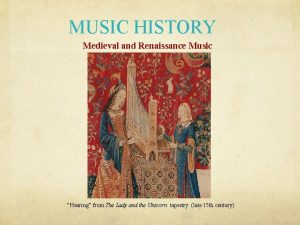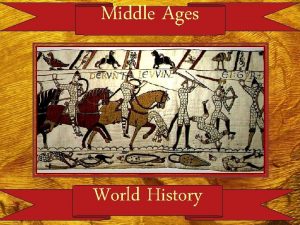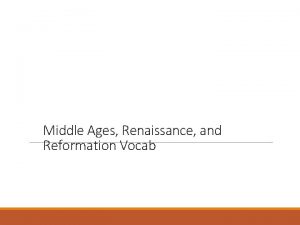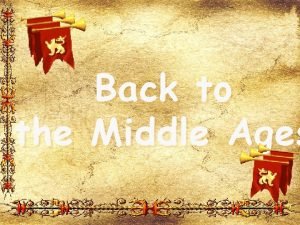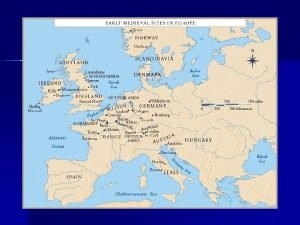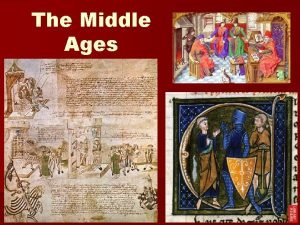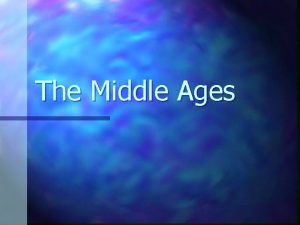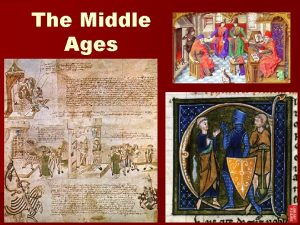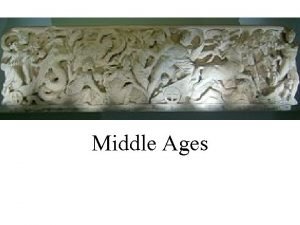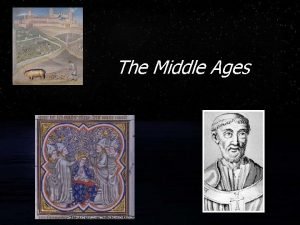Chaucer and The Middle Ages History of Chaucer




























- Slides: 28

Chaucer and The Middle Ages

History of Chaucer � Chaucer was born approximately in 1343 and died 1400. � Chaucer was one of the first great poets to use English, and he was best known for his work entitled The Canterbury Tales. � Geoffrey Chaucer was born between 1340 and 1345, probably in London. His father was a prosperous wine merchant.

History of Chaucer � Chaucer was captured by the French during the Brittany expedition of 1359, but was ransomed by the king. � King Edward III later sent him on diplomatic missions to France, Genoa and Florence. His travels exposed him to the work of authors such as Dante, Boccaccio and Froissart.

History of Chaucer �Around 1366, Chaucer married Philippa Roet, a lady- in-waiting in the queen's household. �They are thought to have had three or four children. �In 1374, Chaucer was appointed comptroller (one in charge of financial importing) of the lucrative London customs. In 1386, he was elected member of parliament for Kent, and he also served as a justice of the peace.

History of Chaucer �In 1389, he was made clerk of the king's works, overseeing royal building projects. He held a number of other royal posts, serving both Edward III and his successor Richard II.

History of Chaucer �Chaucer's first major work was 'The Book of the Duchess', an elegy for the first wife of his patron John of Gaunt. � Other works include 'Parlement of Foules', 'The Legend of Good Women' and 'Troilus and Criseyde'. �In 1387, he began his most famous work, The Canterbury Tales, in which a diverse group of people recount stories to pass the time on a pilgrimage to Canterbury.

History of Chaucer �Chaucer disappears from the historical record in 1400, and is thought to have died soon after. He was buried in Westminster Abbey. �

History of the Middle Ages �‘I place a heavy emphasis on the historic period: � rise of the middle class, status of women in English society’.

History of England in the Middle Ages: The Puritan Revolt � Feudalism was a popular system of government during the Middle Ages. It was a custom widely held throughout Europe, especially in England. � Serfs would work the land for the vassals and lords who owned it in exchange for protection. � Kent, Essex, Sussex, and Belford were counties which were obliged to serve their nobles more than any other county in England.

Peasant’s Revolt �However, some people became upset and unsatisfied with this way of life. They were tired of being treated inferior and worked as slaves when their production of goods was low. �Such a man was John Ball, a priest in Kent who was a vocal opponent of feudalism. He could be heard on Sundays after his sermons voicing his opinions to the commoners and serfs. �The Archbishop of Canterbury imprisoned him several times for his reckless words. Unfortunately, this did not have the affect he desired. Ball continued his public speeches even more frequently.

Peasant’s Revolt �After Ball's last imprisonment of three months, he along with Jack Straw and Wat Tyler inspired more than thirty thousand men to join their crusade. �With the help of some upper class members, they were able to successfully march to London to see King Richard II. �They wanted to see Richard to persuade him to change the current system into one that was fairer and treated everyone equally.

Peasant’s Revolt �Richard at first agreed to meet them, but later changed his mind.

Peasant’s Revolt �When the peasants learned of Richard's resistance to their demands, they stormed London with the help of some sympathizers there. � They carved a trail of death and destruction. Executed were prominent upper class lawyers and other officials. �One wealthy citizen of London, Richard Lyon, was beheaded. The wild frenzy continued in London until it was later crushed by Richard.

Peasant’s Revolt

The Plague �The Bubonic plague, otherwise known as the Black Plague, was transported to Europe from China by way of trade. �The plague was transmitted from the fleas on rats. �Once a person had the plague, they would get red spots on their skin that would later turn black. � 25 million people died in just under five years between 1347 and 1352

The Plague

The Plague �The disease struck and killed people with terrible speed. The Italian writer Boccaccio said its victims often"ate lunch with their friends and dinner with their ancestors in paradise. "

The Plague �By the following August, the plague had spread as far north as England, where people called it "The Black Death" because of the black spots it produced on the skin. A terrible killer was loose across Europe, and Medieval medicine had nothing to combat it. �In winter the disease seemed to disappear, but only because fleas--which were now helping to carry it from person to person--are dormant then. Each spring, the plague attacked again, killing new victims. After five years 25 million people were dead--one-third of Europe's people.

Women of the Middle Ages �Women did not have many rights during this time period. �Medieval Woman were totally dominated by the male members of their family. They were expected to instantly obey not only their father but also their brothers and any other male members of the family. �Medieval girls were beaten into submission and disobedience was seen as a crime against their religion. Medieval Women could not be heirs to their father's titles. All titles would pass from father to son or brother to brother, depending on the circumstances.

Women of the Middle Ages

Women of the Middle Ages �As young as seven girls would be sent away from their home to live with another noble family. She would be taught a range of subjects and skills. Manners and etiquette were of prime importance, including how to curtsey. �Music, dancing , riding and archery were also taught. These young girls were expected to act as servants to the Ladies of the castle - their duties would be to look after clothes and the assist ladies with dressing and coiffure.

Women of the Middle Ages �High ranking young women would take on the role of ladies-in-waiting and were sometimes taught French. During this period a young Medieval woman would also learn about the Medieval Code of Chivalry and Courtly Love.

Women of the Middle Ages �The life of the Women during the Middle Ages was certainly not easy - arranged, loveless marriages, subservient to men, short life expectancy and constant child bearing!

Canterbury, England

Canterbury Tales Intro �At the Tabard Inn in Southwark, the narrator meets up with twenty-seven other pilgrims traveling to the shrine of the martyr, St. Thomas Becket of Canterbury. � The narrator describes twenty-seven pilgrims, including a Knight, Squire, Yeoman, Prioress, Monk, Friar, Merchant, Clerk, Man of Law, Franklin, Haberdasher, Carpenter, Weaver, Dyer, Tapestry. Weaver, Cook, Shipman, Physician, Wife, Parson, Plowman, Miller, Manciple, Reeve, Summoner, Pardoner, and Host.

Canterbury Tales � The Host decides that all the pilgrims should travel together on their way to Canterbury. � To pass the time on their trip, he suggests that they each tell two stories: one on the way to Canterbury and one on the way back. � He decides that he will judge who tells the best story. The winner will receive a meal at Bailey’s Tavern, which will be paid for by the other pilgrims.

Canterbury Tales Intro �The following parts of The Canterbury Tales are the stories of the pilgrims.

Middle Ages Scenes/Structure
 Dark ages def
Dark ages def Renaissance vs medieval art
Renaissance vs medieval art The high and late middle ages section 5 quiz
The high and late middle ages section 5 quiz Middle ages renaissance
Middle ages renaissance Similarities between middle ages and renaissance
Similarities between middle ages and renaissance Monks and nuns in the middle ages
Monks and nuns in the middle ages Nuns in the middle ages
Nuns in the middle ages European middle ages map
European middle ages map Dark ages vs renaissance
Dark ages vs renaissance Germanic kingdom
Germanic kingdom Egyptian floral arrangements
Egyptian floral arrangements Early middle ages
Early middle ages Dark ages mosaic
Dark ages mosaic Late middle ages timeline
Late middle ages timeline Gregorian chant middle ages
Gregorian chant middle ages Renaissance vs middle ages
Renaissance vs middle ages Middle ages def
Middle ages def A metaphorical phrase used to replace a concrete noun
A metaphorical phrase used to replace a concrete noun Astronomy in medieval times
Astronomy in medieval times Roman catholic church hierarchy pyramid
Roman catholic church hierarchy pyramid Middle ages jeopardy
Middle ages jeopardy Middle ages regents questions
Middle ages regents questions Feudal system in the middle ages
Feudal system in the middle ages Education in middle ages
Education in middle ages Middle ages def
Middle ages def Lesson 4 the late middle ages
Lesson 4 the late middle ages Art emerging in europe
Art emerging in europe Middle ages
Middle ages The middle ages spans nearly one thousand years
The middle ages spans nearly one thousand years


